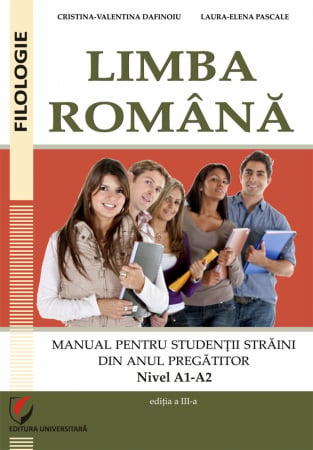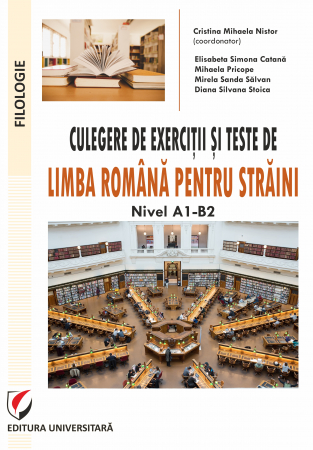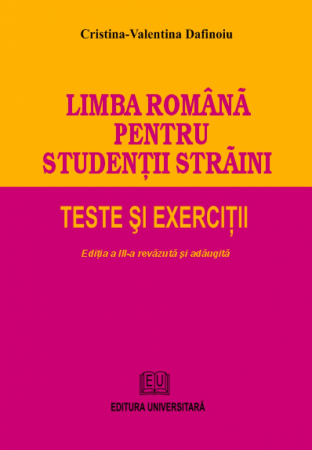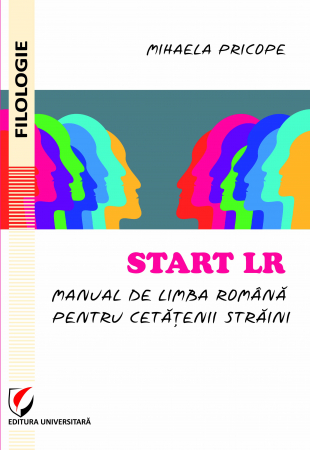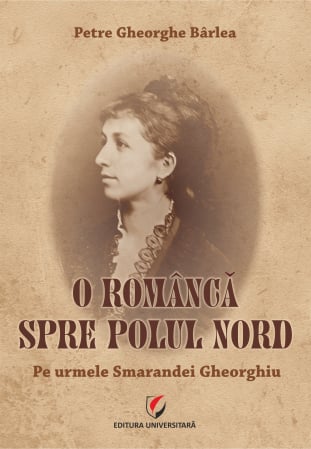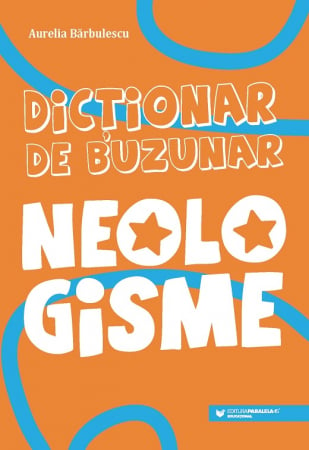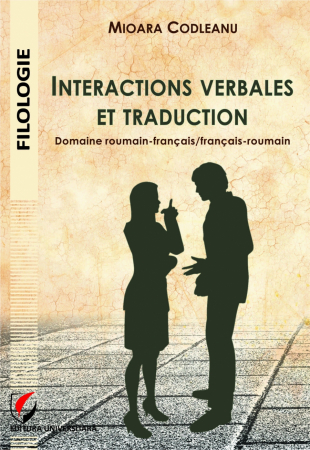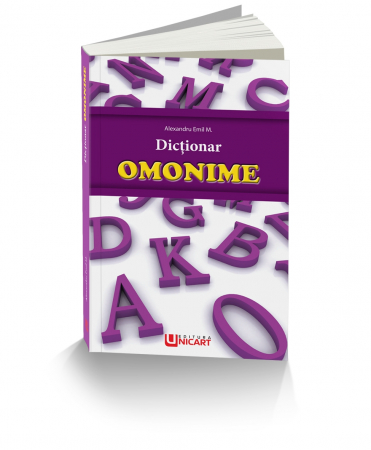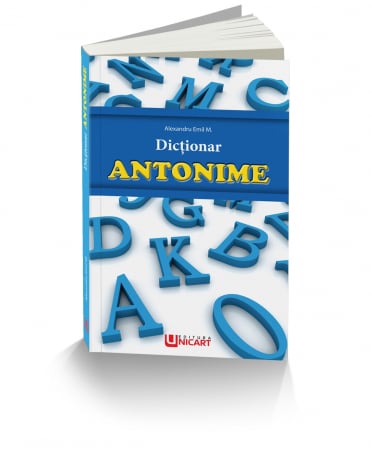Manuscript proposals: [email protected] / 0745 204 115 //// Tracking orders Individuals / Sales: 0745 200 357 / Orders Legal entities: 0721 722 783
Publisher: Editura Universitară
Author: Marinusa Constantin
Edition: I
Pages: 164
Publisher year: 2023
ISBN: 978-606-28-1645-2
DOI: https://doi.org/10.5682/9786062816452
Product Code:
9786062816452
Do you need help?
0745 200 357
- Description
- Download (1)
- Authors
- Content
- More details
- Reviews (0)
Marinusa Constantin's book has everything it needs to fulfill its purpose of "course support". On the one hand, the author summarizes the most recent and most authoritative information regarding the vast and ever-changing issue of the lexicon of a natural language. On the other hand, the organization of the presentation of this rich work material respects the didactic principle of accessibility. In this way, the work is at the point of balance between a scientific treatise and an "introduction" to the sciences that codifies the data of the study of the lexicon during the years of professional training of philology students, respectively lexicology, with its subfields - etymology, word formation, phraseology, semantics , onomastics, lexicography, etc.
From the first perspective, the exposition is gradually systematized, from the general theoretical aspects of vocabulary organization to concrete analyzes of the phenomena, processes and mechanisms that generate the appearance and disappearance of words and meanings from a language, that govern linguistic contacts, the implications of the lexicon in the general structure of a language - i.e. the inter-influences with its phonetics, morphology, syntax, stylistics and pragmatics. Moreover, the terms structure and structuralism, generativism, pragmatics and cognitivism, integral linguistics, with a few specific references to Ferdinand de Saussure, to Émile Benveniste, to J. L. Austin, E. Coseriu s.a., return in the different sections of the book. The author avoids too broad theorizing, because the profile of the work would not justify details of principle, but explains the theoretical, procedural support, by virtue of which the schemes of word formation, lexical-semantic transfer to models of formal-semantic grouping, etc. were arrived at.
The short theoretical justifications, as well as the analyzes and descriptions of the practical manifestation of language facts in the lexical sphere, are based on a corpus of references as rich as such a work allows. More precisely, it is about an essential bibliography, which accumulates older contributions, but belonging to some authorities in the field and who directed the profile research and offered generally accepted solutions to the issue under discussion (cf. O. Densusianu, S. Puscariu, Al. Rosetti, I. Cioranescu, Al. Graur, C. Tagliavini, E. Coseriu, M. Sala, I. Coteanu, A. Bidu‑Vranceanu, N. Forascu, Th. Hristea, M. Avram s.a.), as well as the results of some last-minute researches, which capitalize on the acquisitions and results of specialists from the youngest generations, coordinated by prestigious personalities (see the case of TDG). On the other hand, the solutions offered by the promoters of the international currents of language investigation, such as those mentioned above, from the representatives of comparative-historical grammar, in older or newer versions, to those of structuralism, are used as support for the demonstrations. generativism, pragmatics and cognitivism, statistical analysis, etc.
In other words, the text of the current course aims to introduce students to both the essential and functional issues of lexicology, as well as its research methodology and, no less, the metalanguage related to the study discipline in question. However, this approach coincides with the requirements of Level 1, fundamental, of the professional skills training grid in higher education (cf. the NQF framework matrix).
From the second perspective, the didactic one, in addition to the systematic organization of the study material and in addition to the observance of the principle "No affirmation, no demonstration and no demonstration, no examples!", the various psycho-pedagogical strategies applied by Marinusa Constantin stand out. Resuming from several angles of view some more difficult aspects in explaining the facts of the language, diversifying the examples, so that both the fundamental mechanisms and the details of some lexical-semantic phenomena can be clarified, then balancing the exposition between diachrony and synchrony, between general and particularly, between form and content, between paradigmatic and syntagmatic, between usual-denotative and special-expressive, accompanied by the pragmatic analysis of connotative values, when the context requires it, confers the instructive-formative efficiency of the present work. If we add to these the careful placement of the text on the page, the graphs and the synoptic tables, the explanatory notes - short and clear, the application exercises proposed for each "unit" of presentation of the lexical subsystem of the Romanian language, we can say that we have an image of the "good work made".
For a young university student, this book is proof of seriousness, passion and dedication, i.e. a proof of professionalism - auspicious.
Petre Gheorghe BARLEA
From the first perspective, the exposition is gradually systematized, from the general theoretical aspects of vocabulary organization to concrete analyzes of the phenomena, processes and mechanisms that generate the appearance and disappearance of words and meanings from a language, that govern linguistic contacts, the implications of the lexicon in the general structure of a language - i.e. the inter-influences with its phonetics, morphology, syntax, stylistics and pragmatics. Moreover, the terms structure and structuralism, generativism, pragmatics and cognitivism, integral linguistics, with a few specific references to Ferdinand de Saussure, to Émile Benveniste, to J. L. Austin, E. Coseriu s.a., return in the different sections of the book. The author avoids too broad theorizing, because the profile of the work would not justify details of principle, but explains the theoretical, procedural support, by virtue of which the schemes of word formation, lexical-semantic transfer to models of formal-semantic grouping, etc. were arrived at.
The short theoretical justifications, as well as the analyzes and descriptions of the practical manifestation of language facts in the lexical sphere, are based on a corpus of references as rich as such a work allows. More precisely, it is about an essential bibliography, which accumulates older contributions, but belonging to some authorities in the field and who directed the profile research and offered generally accepted solutions to the issue under discussion (cf. O. Densusianu, S. Puscariu, Al. Rosetti, I. Cioranescu, Al. Graur, C. Tagliavini, E. Coseriu, M. Sala, I. Coteanu, A. Bidu‑Vranceanu, N. Forascu, Th. Hristea, M. Avram s.a.), as well as the results of some last-minute researches, which capitalize on the acquisitions and results of specialists from the youngest generations, coordinated by prestigious personalities (see the case of TDG). On the other hand, the solutions offered by the promoters of the international currents of language investigation, such as those mentioned above, from the representatives of comparative-historical grammar, in older or newer versions, to those of structuralism, are used as support for the demonstrations. generativism, pragmatics and cognitivism, statistical analysis, etc.
In other words, the text of the current course aims to introduce students to both the essential and functional issues of lexicology, as well as its research methodology and, no less, the metalanguage related to the study discipline in question. However, this approach coincides with the requirements of Level 1, fundamental, of the professional skills training grid in higher education (cf. the NQF framework matrix).
From the second perspective, the didactic one, in addition to the systematic organization of the study material and in addition to the observance of the principle "No affirmation, no demonstration and no demonstration, no examples!", the various psycho-pedagogical strategies applied by Marinusa Constantin stand out. Resuming from several angles of view some more difficult aspects in explaining the facts of the language, diversifying the examples, so that both the fundamental mechanisms and the details of some lexical-semantic phenomena can be clarified, then balancing the exposition between diachrony and synchrony, between general and particularly, between form and content, between paradigmatic and syntagmatic, between usual-denotative and special-expressive, accompanied by the pragmatic analysis of connotative values, when the context requires it, confers the instructive-formative efficiency of the present work. If we add to these the careful placement of the text on the page, the graphs and the synoptic tables, the explanatory notes - short and clear, the application exercises proposed for each "unit" of presentation of the lexical subsystem of the Romanian language, we can say that we have an image of the "good work made".
For a young university student, this book is proof of seriousness, passion and dedication, i.e. a proof of professionalism - auspicious.
Petre Gheorghe BARLEA
-
The contemporary Romanian language. The vocabulary
Download
MARINUSA CONSTANTIN has a degree in philology, the Romanian-French specialty, with a master's degree in multiculturalism and plurilingualism. In the period 2013-2016, he attended the Doctoral School of Humanities, Field of Philology, at the Ovidius University of Constanta, obtaining the title of Doctor of Philology (Summa cum laude), with the thesis Delocutionary Derivation in the Old Romanian language, under the scientific guidance of university professor Dr. Petre Gheorghe Barlea.
She participated in numerous scientific events in Constanta, Bucharest, Targoviste, Brussels, etc., he was part of research projects and editing of collective works - manuals, specialized dictionaries (DLI, 1st and 2nd ed.), academic journals. She is the associate coordinator of the most recent annual editions of the volume Didactic studies (of language and literature) and a member of the editorial team of the periodical Culture and Communication - published by the Bucharest University Publishing House. She is a member of the organizing team of the international colloquium "Latinity - Romanity - Romanity", Targoviste, editions XV-XXI.
She participated in numerous scientific events in Constanta, Bucharest, Targoviste, Brussels, etc., he was part of research projects and editing of collective works - manuals, specialized dictionaries (DLI, 1st and 2nd ed.), academic journals. She is the associate coordinator of the most recent annual editions of the volume Didactic studies (of language and literature) and a member of the editorial team of the periodical Culture and Communication - published by the Bucharest University Publishing House. She is a member of the organizing team of the international colloquium "Latinity - Romanity - Romanity", Targoviste, editions XV-XXI.
FOREWORD (P.G.B.) / 9
Unit 1. INTRODUCTION TO LEXICOLOGY / 11
1.1. Language structure - general considerations / 11
1.2. Lexicology and related disciplines / 14
1.3. The word – the basic unit of the lexicon / 15
1.4. Related disciplines of lexicology / 20
1.5. Lexicon organization criteria / 21
1.6. Bibliography / 23
1.7. Applications / 24
Unit 2. FUNCTIONAL-HIERARCHICAL ORGANIZATION OF THE VOCABULARY / 25
2.1. Fundamental vocabulary and vocabulary table / 25
2.1.1. Basic vocabulary / 25
2.1.2. Vocabulary table / 29
2.2. Active ~ passive vocabulary / 29
2.3. Literary ~ non-literary vocabulary / 31
2.3.1. Literary vocabulary / 31
2.3.2. Non-literary vocabulary / 31
2.4. The dynamics of the lexicon / 32
2.5. Applications / 35
2.6. Bibliography / 36
Unit 3. SEMANTIC ORGANIZATION OF VOCABULARY / 36
3.1. Semantic relations / 38
3.1.1. Synonymy / 38
3.1.2. Antonyms / 40
3.1.3. Homonymy / 42
3.1.4. Paronymy / 43
3.1.5. Polysemy / 46
3.1.6. The semantic field / 47
3.2. Bibliography / 49
3.3. Applications / 50
Unit 4. ETYMOLOGICAL ORGANIZATION OF THE LEXICON (I) / 51
4.1. Etymology - primary lexemes and lexemes formed through internal processes / 51
4.2. The etymological stratification of the Romanian language / 55
4.2.1. The Tracho-Dac substrate / 56
4.2.2. The Latin basis of the Romanian language / 58
4.2.3. The Slavic superstratum / 66
4.2.4. Abstract and old influences / 69
4.3. Conclusions regarding the old layers of the Romanian language / 77
4.4. Bibliography / 78
4.5. Applications / 80
Unit 5. ETYMOLOGICAL ORGANIZATION OF THE LEXICON (II) / 85
5.1. Modern loans / 85
5.2. Lexical elements from scholarly Latin / 87
5.3. French influence / 89
5.4. Italian influence / 92
5.5. German influence / 93
5.6. English influence / 93
5.7. Bibliography / 96
5.8. Applications / 99
Unit 6. FORMATION OF WORDS IN ROMANIAN LANGUAGE / 100
6.1. Word formation / 100
6.2. Derivational morphology / 102
6.2.1. Concepts related to derivational morphology / 102
6.2.2. Derivation typology / 105
6.2.3. Derivation with suffixes. Types of suffixes and derivatives / 106
6.2.4. Other semantic values of substantive suffixes / 118
6.2.5. Semantic relations between suffixes/nominal derivatives / 122
6.2.6. Derivation with prefixes / 124
6.2.7. Parasynthetic derivation / 131
6.2.8. Regressive derivation / 132
6.2.9. Conclusions regarding derivational morphology / 133
6.3. Composition / 134
6.3.1. Syntactic patterns of composition / 136
6.3.1.1. Compound results by hypotax (subordination relationship) / 136
6.3.1.2. Compounds made by parataxis (coordination relationship) / 138
6.3.1.3. Pseudoparataxis (false parataxis) / 139
6.3.2. Composition by abbreviation / 139
6.3.3. Mixed composition / 139
6.3.4. Parasynthetic composition / 140
6.3.5. Composition with scientific elements / 140
6.4. Conversion / 142
6.4.1. Substantivization / 144
6.4.2. Substantivization produced by metalanguage / 148
6.4.3. Adjective / 145
6.4.4. Adverbialization / 152
6.5. Conclusions regarding the internal means of enriching the lexicon / 155
6.6. Bibliography /155
6.7. Applications / 157
Unit 7. LINGUISTIC CALCULATION – MIXED VOCABULARY ENRICHMENT PROCEDURE / 159
7.1. Linguistic calculation / 159
7.2. Types of linguistic calculations / 160
7.2.1. Lexical calculation / 160
7.2.2. Calculation of morphematic structure / 160
7.2.3. Semantic structure calculation/ 161
7.2.4. Grammatical calculation / 162
7.2.5. Phraseological calculation / 162
7.3. Bibliography / 163
7.4. Applications / 164
Unit 1. INTRODUCTION TO LEXICOLOGY / 11
1.1. Language structure - general considerations / 11
1.2. Lexicology and related disciplines / 14
1.3. The word – the basic unit of the lexicon / 15
1.4. Related disciplines of lexicology / 20
1.5. Lexicon organization criteria / 21
1.6. Bibliography / 23
1.7. Applications / 24
Unit 2. FUNCTIONAL-HIERARCHICAL ORGANIZATION OF THE VOCABULARY / 25
2.1. Fundamental vocabulary and vocabulary table / 25
2.1.1. Basic vocabulary / 25
2.1.2. Vocabulary table / 29
2.2. Active ~ passive vocabulary / 29
2.3. Literary ~ non-literary vocabulary / 31
2.3.1. Literary vocabulary / 31
2.3.2. Non-literary vocabulary / 31
2.4. The dynamics of the lexicon / 32
2.5. Applications / 35
2.6. Bibliography / 36
Unit 3. SEMANTIC ORGANIZATION OF VOCABULARY / 36
3.1. Semantic relations / 38
3.1.1. Synonymy / 38
3.1.2. Antonyms / 40
3.1.3. Homonymy / 42
3.1.4. Paronymy / 43
3.1.5. Polysemy / 46
3.1.6. The semantic field / 47
3.2. Bibliography / 49
3.3. Applications / 50
Unit 4. ETYMOLOGICAL ORGANIZATION OF THE LEXICON (I) / 51
4.1. Etymology - primary lexemes and lexemes formed through internal processes / 51
4.2. The etymological stratification of the Romanian language / 55
4.2.1. The Tracho-Dac substrate / 56
4.2.2. The Latin basis of the Romanian language / 58
4.2.3. The Slavic superstratum / 66
4.2.4. Abstract and old influences / 69
4.3. Conclusions regarding the old layers of the Romanian language / 77
4.4. Bibliography / 78
4.5. Applications / 80
Unit 5. ETYMOLOGICAL ORGANIZATION OF THE LEXICON (II) / 85
5.1. Modern loans / 85
5.2. Lexical elements from scholarly Latin / 87
5.3. French influence / 89
5.4. Italian influence / 92
5.5. German influence / 93
5.6. English influence / 93
5.7. Bibliography / 96
5.8. Applications / 99
Unit 6. FORMATION OF WORDS IN ROMANIAN LANGUAGE / 100
6.1. Word formation / 100
6.2. Derivational morphology / 102
6.2.1. Concepts related to derivational morphology / 102
6.2.2. Derivation typology / 105
6.2.3. Derivation with suffixes. Types of suffixes and derivatives / 106
6.2.4. Other semantic values of substantive suffixes / 118
6.2.5. Semantic relations between suffixes/nominal derivatives / 122
6.2.6. Derivation with prefixes / 124
6.2.7. Parasynthetic derivation / 131
6.2.8. Regressive derivation / 132
6.2.9. Conclusions regarding derivational morphology / 133
6.3. Composition / 134
6.3.1. Syntactic patterns of composition / 136
6.3.1.1. Compound results by hypotax (subordination relationship) / 136
6.3.1.2. Compounds made by parataxis (coordination relationship) / 138
6.3.1.3. Pseudoparataxis (false parataxis) / 139
6.3.2. Composition by abbreviation / 139
6.3.3. Mixed composition / 139
6.3.4. Parasynthetic composition / 140
6.3.5. Composition with scientific elements / 140
6.4. Conversion / 142
6.4.1. Substantivization / 144
6.4.2. Substantivization produced by metalanguage / 148
6.4.3. Adjective / 145
6.4.4. Adverbialization / 152
6.5. Conclusions regarding the internal means of enriching the lexicon / 155
6.6. Bibliography /155
6.7. Applications / 157
Unit 7. LINGUISTIC CALCULATION – MIXED VOCABULARY ENRICHMENT PROCEDURE / 159
7.1. Linguistic calculation / 159
7.2. Types of linguistic calculations / 160
7.2.1. Lexical calculation / 160
7.2.2. Calculation of morphematic structure / 160
7.2.3. Semantic structure calculation/ 161
7.2.4. Grammatical calculation / 162
7.2.5. Phraseological calculation / 162
7.3. Bibliography / 163
7.4. Applications / 164
Marinusa Constantin's book has everything it needs to fulfill its purpose of "course support". On the one hand, the author summarizes the most recent and most authoritative information regarding the vast and ever-changing issue of the lexicon of a natural language. On the other hand, the organization of the presentation of this rich work material respects the didactic principle of accessibility. In this way, the work is at the point of balance between a scientific treatise and an "introduction" to the sciences that codifies the data of the study of the lexicon during the years of professional training of philology students, respectively lexicology, with its subfields - etymology, word formation, phraseology, semantics , onomastics, lexicography, etc.
From the first perspective, the exposition is gradually systematized, from the general theoretical aspects of vocabulary organization to concrete analyzes of the phenomena, processes and mechanisms that generate the appearance and disappearance of words and meanings from a language, that govern linguistic contacts, the implications of the lexicon in the general structure of a language - i.e. the inter-influences with its phonetics, morphology, syntax, stylistics and pragmatics. Moreover, the terms structure and structuralism, generativism, pragmatics and cognitivism, integral linguistics, with a few specific references to Ferdinand de Saussure, to Émile Benveniste, to J. L. Austin, E. Coseriu s.a., return in the different sections of the book. The author avoids too broad theorizing, because the profile of the work would not justify details of principle, but explains the theoretical, procedural support, by virtue of which the schemes of word formation, lexical-semantic transfer to models of formal-semantic grouping, etc. were arrived at.
The short theoretical justifications, as well as the analyzes and descriptions of the practical manifestation of language facts in the lexical sphere, are based on a corpus of references as rich as such a work allows. More precisely, it is about an essential bibliography, which accumulates older contributions, but belonging to some authorities in the field and who directed the profile research and offered generally accepted solutions to the issue under discussion (cf. O. Densusianu, S. Puscariu, Al. Rosetti, I. Cioranescu, Al. Graur, C. Tagliavini, E. Coseriu, M. Sala, I. Coteanu, A. Bidu‑Vranceanu, N. Forascu, Th. Hristea, M. Avram s.a.), as well as the results of some last-minute researches, which capitalize on the acquisitions and results of specialists from the youngest generations, coordinated by prestigious personalities (see the case of TDG). On the other hand, the solutions offered by the promoters of the international currents of language investigation, such as those mentioned above, from the representatives of comparative-historical grammar, in older or newer versions, to those of structuralism, are used as support for the demonstrations. generativism, pragmatics and cognitivism, statistical analysis, etc.
In other words, the text of the current course aims to introduce students to both the essential and functional issues of lexicology, as well as its research methodology and, no less, the metalanguage related to the study discipline in question. However, this approach coincides with the requirements of Level 1, fundamental, of the professional skills training grid in higher education (cf. the NQF framework matrix).
From the second perspective, the didactic one, in addition to the systematic organization of the study material and in addition to the observance of the principle "No affirmation, no demonstration and no demonstration, no examples!", the various psycho-pedagogical strategies applied by Marinusa Constantin stand out. Resuming from several angles of view some more difficult aspects in explaining the facts of the language, diversifying the examples, so that both the fundamental mechanisms and the details of some lexical-semantic phenomena can be clarified, then balancing the exposition between diachrony and synchrony, between general and particularly, between form and content, between paradigmatic and syntagmatic, between usual-denotative and special-expressive, accompanied by the pragmatic analysis of connotative values, when the context requires it, confers the instructive-formative efficiency of the present work. If we add to these the careful placement of the text on the page, the graphs and the synoptic tables, the explanatory notes - short and clear, the application exercises proposed for each "unit" of presentation of the lexical subsystem of the Romanian language, we can say that we have an image of the "good work made".
For a young university student, this book is proof of seriousness, passion and dedication, i.e. a proof of professionalism - auspicious.
Petre Gheorghe BARLEA
From the first perspective, the exposition is gradually systematized, from the general theoretical aspects of vocabulary organization to concrete analyzes of the phenomena, processes and mechanisms that generate the appearance and disappearance of words and meanings from a language, that govern linguistic contacts, the implications of the lexicon in the general structure of a language - i.e. the inter-influences with its phonetics, morphology, syntax, stylistics and pragmatics. Moreover, the terms structure and structuralism, generativism, pragmatics and cognitivism, integral linguistics, with a few specific references to Ferdinand de Saussure, to Émile Benveniste, to J. L. Austin, E. Coseriu s.a., return in the different sections of the book. The author avoids too broad theorizing, because the profile of the work would not justify details of principle, but explains the theoretical, procedural support, by virtue of which the schemes of word formation, lexical-semantic transfer to models of formal-semantic grouping, etc. were arrived at.
The short theoretical justifications, as well as the analyzes and descriptions of the practical manifestation of language facts in the lexical sphere, are based on a corpus of references as rich as such a work allows. More precisely, it is about an essential bibliography, which accumulates older contributions, but belonging to some authorities in the field and who directed the profile research and offered generally accepted solutions to the issue under discussion (cf. O. Densusianu, S. Puscariu, Al. Rosetti, I. Cioranescu, Al. Graur, C. Tagliavini, E. Coseriu, M. Sala, I. Coteanu, A. Bidu‑Vranceanu, N. Forascu, Th. Hristea, M. Avram s.a.), as well as the results of some last-minute researches, which capitalize on the acquisitions and results of specialists from the youngest generations, coordinated by prestigious personalities (see the case of TDG). On the other hand, the solutions offered by the promoters of the international currents of language investigation, such as those mentioned above, from the representatives of comparative-historical grammar, in older or newer versions, to those of structuralism, are used as support for the demonstrations. generativism, pragmatics and cognitivism, statistical analysis, etc.
In other words, the text of the current course aims to introduce students to both the essential and functional issues of lexicology, as well as its research methodology and, no less, the metalanguage related to the study discipline in question. However, this approach coincides with the requirements of Level 1, fundamental, of the professional skills training grid in higher education (cf. the NQF framework matrix).
From the second perspective, the didactic one, in addition to the systematic organization of the study material and in addition to the observance of the principle "No affirmation, no demonstration and no demonstration, no examples!", the various psycho-pedagogical strategies applied by Marinusa Constantin stand out. Resuming from several angles of view some more difficult aspects in explaining the facts of the language, diversifying the examples, so that both the fundamental mechanisms and the details of some lexical-semantic phenomena can be clarified, then balancing the exposition between diachrony and synchrony, between general and particularly, between form and content, between paradigmatic and syntagmatic, between usual-denotative and special-expressive, accompanied by the pragmatic analysis of connotative values, when the context requires it, confers the instructive-formative efficiency of the present work. If we add to these the careful placement of the text on the page, the graphs and the synoptic tables, the explanatory notes - short and clear, the application exercises proposed for each "unit" of presentation of the lexical subsystem of the Romanian language, we can say that we have an image of the "good work made".
For a young university student, this book is proof of seriousness, passion and dedication, i.e. a proof of professionalism - auspicious.
Petre Gheorghe BARLEA
If you want to express your opinion about this product you can add a review.
write a review

6359.png)
![The contemporary Romanian language. The vocabulary - Marinusa Constantin [1] The contemporary Romanian language. The vocabulary - Marinusa Constantin [1]](https://gomagcdn.ro/domains/editurauniversitara.ro/files/product/large/limba-romana-contemporana-vocabularul-030075.jpg)
